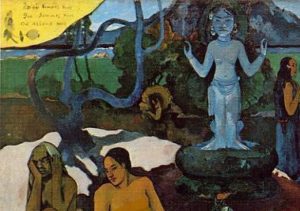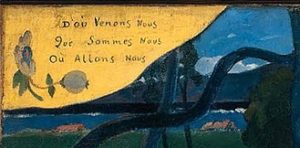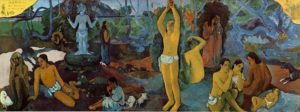Writing to his art dealer in 1898, Gauguin proclaimed:
“…I have finished a philosophical work on a theme comparable to that of the Gospel.”[1]
At first glance, Gauguin’s celebrated painting doesn’t appear to fit such a description, but a deeper look reveals more. Paul Gauguin attended Catholic boarding school in France and was exposed to Christianity and the teachings of the Bible early in life. Unfortunately, his adult life was a series of moral failures and broken relationships, as he indulged “…his need to escape from the constraints and commitments of life and find an impossible fulfillment in the never-never world of sun, pleasure, and free love.”[2] If you’re not familiar with Gauguin’s history, he abandoned his wife and children around 1891 (age 43), fled to Tahiti, and engaged in lasciviousness with young native women, one estimated to be as young as 13.
Back to the painting—we find it comparable to the gospel, at least the first half. This is generally referred to as “the bad news”. The imagery in Gauguin’s painting is read right to left like an ancient language, revealing the realities of human existence: birth, life, and inevitable decline. Notably, the figure in the center recalls the eating of forbidden fruit by our first parents in the Garden of Eden which ushered death into the world. Moving left, we see the effects of the curse on humanity. An enigmatic idol in the background offers no solution and no hope.
Instead of communicating the second half of the gospel, Gauguin left his viewers with only imminent death and 3 yearning questions scribbled in the upper left-hand corner. Notably, they are catechistic questions that likely lingered in his memory from his Catholic upbringing. They serve as the title of the painting:


Where do we come from? What are we? Where are we going?
Gauguin knew the answers. Why did he leave us with only imminent death and mystery? The Apostle Paul tells us that those who rebel against God suppress the truth because refuse to honor God and desire to live without accountability. Paul explains in verse 21-22:
“For although they knew God, they did not honor him as God or give thanks to him, but they became futile in their thinking, and their foolish hearts were darkened. Claiming to be wise, they became fools, and exchanged the glory of the immortal God for images resembling mortal man…” (Romans 1:21-23)
Despite Gauguin’s unwillingness to honor God, his painting points to God just the same. A more accurate title for the work would be “Truth Pops Up in Tahiti”, for inquiry itself presupposes a rational mind created by God and only the Christian faith can supply coherent, consistent answers to questions of origins, meaning, and destiny.
Where do we come from?
In the beginning, God created the world and everything in it. (Gen. 1-2)
What are we?
We are beings created in God’s own image. Due to the sin of our first parents, Adam and Eve, we live in a fallen world and are subject to aging and death. (Gen. 2-3)
Where are we going?
We’re headed for Hell because of our sins, but God in His rich mercy sent his Son, Jesus Christ, into the world to pay the penalty we deserved and now offers us the free gift of salvation. This is the good news Gauguin left out of his painting:
“God shows his love for us in that while we were still sinners, Christ died for us.” (Romans 5:8)
We need not face death with open-ended questions obscured in the mystery of nameless stone statues. If we haven’t already, we can repent of our sins today, turn to Christ in faith, and receive the free gift of salvation.
Perhaps in the past year, you’ve asked one of these questions. The turmoil and chaos we’re seeing in the world is confusing, and the fear of death due to the Coronavirus has gripped many hearts. God provided us with the answer to these questions long before Gauguin scribbled them in the corner of his canvas. The answers are found in the Gospel.
[1] The Wisdom of Paul Gauguin—Artist,” International Studio, volume 73, number 291, 69.
[2] Wendy Beckett, 1000 Masterpieces (Dorling Kindersley: London), 163.

Excellent! Passing this on to one daughter who is studying worldview, and another who loves art (and worldview).
Thanks for the positive feedback! Have a blessed weekend ~Scarlett